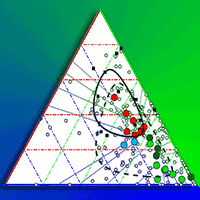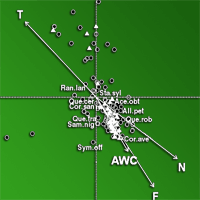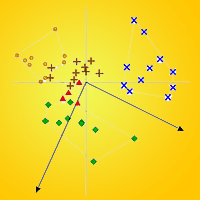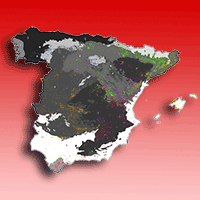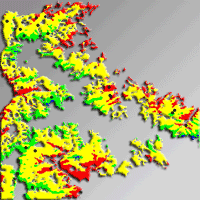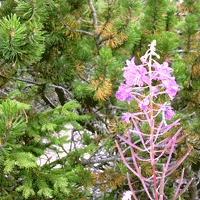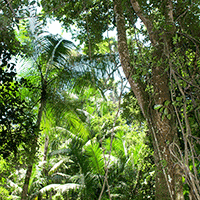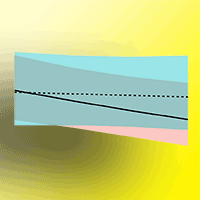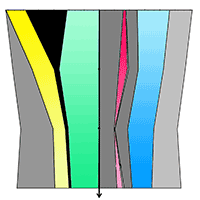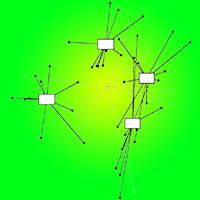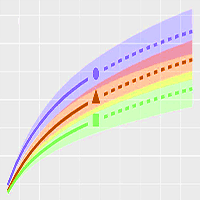
Growing at the forest edges: how natural regeneration develops under fragmentation
Lhoraynne Pereira Gomes (1) , Patrícia Borges Dias (2), Henrique Machado Dias (3), Sustanis Horn Kunz (3)
iForest - Biogeosciences and Forestry, Volume 15, Issue 4, Pages 248-255 (2022)
doi: https://doi.org/10.3832/ifor3834-015
Published: Jul 19, 2022 - Copyright © 2022 SISEF
Research Articles
Abstract
Environmental changes caused by edge effects and matrix land use can interfere with plant community resilience and, consequently, alter forest succession. Here, we aimed to (i) investigate whether species composition, density and richness in a forest’s regeneration layer vary in its edge-to-interior gradient and (ii) analyze the relationship between regeneration and local abiotic variables. We conducted the study in the lowland rainforest of the Atlantic Forest biodiversity hotspot at the Córrego Grande Biological Reserve, Espírito Santo state, Brazil. We sampled the regeneration layer in two edge environments with different matrices (forest and road) and the fragmented interior to link vegetation structure with environmental variables. In each environment, we set up 12 plots of 5 × 10 m size and recorded, in each plot, the height and stem base diameter of all living individuals above 50 cm of height and below 2.5 cm of diameter at breast height (1.30 m height). We applied different multivariate analyses to assess the influence of environmental data, such as canopy openness and physical-chemical soil variables. The three environments shared 22 out of the 174 morphospecies recorded, and the forest-side edge had the lowest species richness among all environments. The environmental variables that better explained the distribution of species across the three environments were: canopy openness, soil penetration resistance, zinc, and calcium content. Our results revealed significant environmental differences among the forest edges and the forest interior of the study site, highlighting the relevant role of the forest surrounding matrix for the maintenance of protected remnants.
Keywords
Seedling, Forest Resilience, Biological Reserve, Environmental Variables
Authors’ Info
Authors’ address
Programa de Pós-Graduação em Botnica, Laboratório de Ecologia e Evolução de Plantas - LEEP, Departamento de Biologia Vegetal, Universidade Federal de Viçosa, Viçosa, Minas Gerais, CEP 36570-900 (Brazil)
Programa de Pós-graduação em Ciências Florestais, Núcleo de Pesquisa Científica e Tecnológica em Meio Ambiente, Silvicultura e Ecologia - NUPEMASE, Universidade Federal do Espírito Santo (Brazil)
Sustanis Horn Kunz 0000-0001-6937-7787
Departamento de Ciências Florestais e da Madeira, Núcleo de Pesquisa Científica e Tecnológica em Meio Ambiente, Silvicultura e Ecologia - NUPEMASE, Universidade Federal do Espírito Santo (Brazil)
Corresponding author
Paper Info
Citation
Pereira Gomes L, Borges Dias P, Machado Dias H, Horn Kunz S (2022). Growing at the forest edges: how natural regeneration develops under fragmentation. iForest 15: 248-255. - doi: 10.3832/ifor3834-015
Academic Editor
Michele Carbognani
Paper history
Received: Apr 01, 2021
Accepted: May 11, 2022
First online: Jul 19, 2022
Publication Date: Aug 31, 2022
Publication Time: 2.30 months
Copyright Information
© SISEF - The Italian Society of Silviculture and Forest Ecology 2022
Open Access
This article is distributed under the terms of the Creative Commons Attribution-Non Commercial 4.0 International (https://creativecommons.org/licenses/by-nc/4.0/), which permits unrestricted use, distribution, and reproduction in any medium, provided you give appropriate credit to the original author(s) and the source, provide a link to the Creative Commons license, and indicate if changes were made.
Web Metrics
Breakdown by View Type
Article Usage
Total Article Views: 9014
(from publication date up to now)
Breakdown by View Type
HTML Page Views: 4192
Abstract Page Views: 2840
PDF Downloads: 1563
Citation/Reference Downloads: 4
XML Downloads: 415
Web Metrics
Days since publication: 1242
Overall contacts: 9014
Avg. contacts per week: 50.80
Citation Metrics
Article Citations
Article citations are based on data periodically collected from the Clarivate Web of Science web site
(last update: Mar 2025)
Total number of cites (since 2022): 3
Average cites per year: 0.75
Publication Metrics
by Dimensions ©
Articles citing this article
List of the papers citing this article based on CrossRef Cited-by.
References
Efeito de borda na estrutura de espécies arbóreas em um fragmento de floresta ombrófila densa, Recife, PE [Edge effect in structure of arboreous species in a Dense Ombrophylous Forest fragment in Recife, Pernambuco - Brazil]. Revista Brasileira de Ciências Agrárias 1: 49-56. [in Portuguese]
CrossRef | Gscholar
Levantamento florístico de um remanescente de Mata Atlntica no litoral norte do Estado da Bahia, Brasil [Floristic survey from an Atlantic Forest remnant on the northern coast of Bahia State, Brazil]. Hoehnea 42: 581-595. [in Portuguese]
CrossRef | Gscholar
Habitat filtering across tree life stages in tropical forest communities. Proceedings of the Royal Society B: Biological Sciences 280: 20130548.
CrossRef | Gscholar
Regeneração de florestas tropicais [Tropical forest regeneration]. Boletim do Museu Paraense Emílio Goeldi - Ciências Naturais 7: 24. [in Portuguese]
Gscholar
A ferro e fogo: a história e a devastação da Mata Atlntica brasileira [By fire and iron: the history and devastation of the Brazilian Atlantic Forest]. CIA, das Letras, São Paulo, Brazil, pp. 484. [in Portuguese]
Gscholar
Manual de métodos de análise de solo [Soil analysis methods manual]. EMBRAPA-CNPS, Rio de Janeiro, Brazil, pp. 212. [in Portuguese]
Gscholar
Vegetation and microclimatic edge effects in two mixed-mesophytic forest fragments. Plant Ecology 21-35.
Gscholar
Jesus RM, Rolim SG (2005) Fitossociologia da floresta atlntica de tabuleiro em Linhares (ES) [Phytosociology of the Atlantic Tableland Forest in Linhares (ES)]. Boletim Técnico SIF 19: 1-149. [in Portuguese]
Gscholar
Variações estruturais e características edáficas em diferentes estádios sucessionais de floresta ciliar de Tabuleiro, ES [Structural changes and edaphic characteristics in different succession stages of Tabuleiro riparian forest, ES]. Revista Árvore 35: 445-456. [in Portuguese]
CrossRef | Gscholar
Aims and methods of vegetation ecology. Wiley, New York, USA, pp. 547.
Gscholar
Florística e estrutura de fragmentos florestais no entorno [Floristics and structure of forest fragments surrounding Juparanã lake, Linhares, Espírito Santo, Brazil]. Boletim do Museu de Biologia Prof Mello Leitão 26: 5-23. [in Portuguese]
Gscholar
Tabuleiro Forests North of Rio Doce: their representation in the Vale do Rio Doce Natural Reserve, Espírito Santo, Brazil. In: “The Atlantic Coastal Forest of Northeastern Brazil” (Thomas WW, Britton EG eds). Memoirs of the New York Botanical Garden, New York, USA, pp. 319-350.
Gscholar
Florestas de Tabuleiro [Tabuleiro forests]. In: “Espécies da flora ameaçadas de extinção no estado do Espírito Santo” [Endangered species of flora in the state of Espírito Santo] (Simonelli M, Fraga CN eds). IPEMA, Vitória, Brazil, pp. 33-44. [in Portuguese]
Gscholar
Influência da distncia da borda e do adensamento foliar sobre a abundncia de plantas pioneiras em um fragmento de floresta tropical submontana na Estação Ecológica de Wenceslau Guimarães (Bahia, Brasil) [Influence of edge distance and leaf density on the abundance of pioneer plants in a patch of tropical submontane forest in the Ecological Station of Wenceslau Guimarães (Bahia, Brazil)]. Acta Botanica Brasilica 26: 197-202. [in Portuguese]
CrossRef | Gscholar
Teoria e teste experimental de fórmulas de transformaçáo dos dados de penetrômetro de impacto em resistência de solo [Theory and test of formulas for transforming impact penetrometer data in soil resistance]. Revista Brasileira de Ciências do Solo 15: 229-235. [in Portuguese]
Gscholar
ggplot2: elegant graphics for data analysis. Springer, New York, USA, pp. 266.
Gscholar

